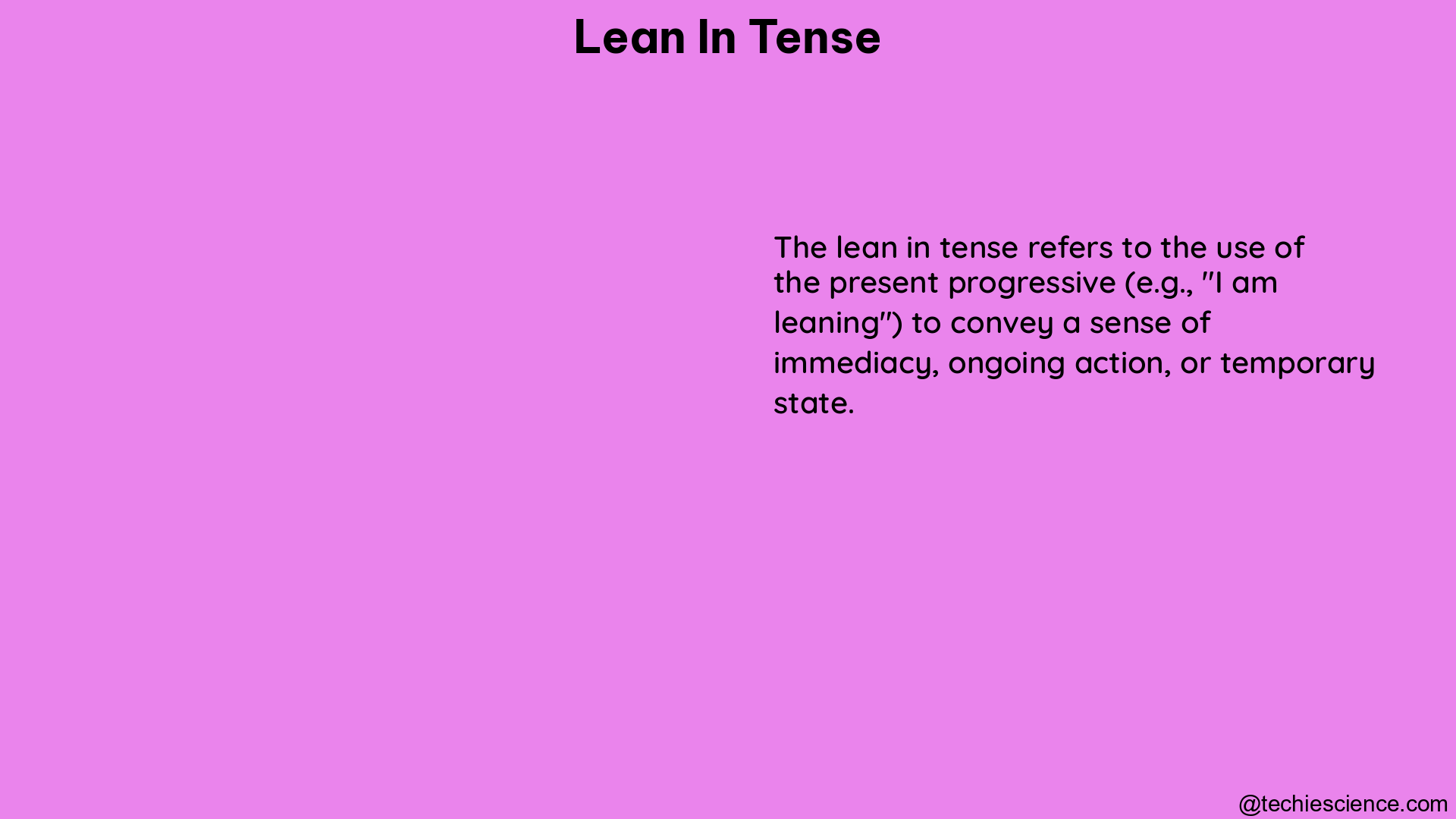The verb “lean” is a versatile word that can take on various forms depending on the tense and context. Whether you’re describing a physical action, expressing a state of mind, or using the phrase “lean in,” understanding the nuances of the lean verb tenses is crucial for effective communication. In this comprehensive guide, we’ll delve into the intricate details of the lean verb tenses, providing you with a thorough understanding of their usage and conjugation.
Present Tense
The present tense of the verb “lean” is straightforward, with the base form being “lean.” The conjugation follows the standard pattern:
- I lean
- You lean
- He/She/It leans
- We lean
- You lean
- They lean
It’s important to note that the third-person singular form, “he/she/it leans,” is the only one that takes an “s” at the end.
Past Tense

The past tense of “lean” can take two forms: “leaned” (pronounced as “leend”) or “leant” (pronounced as “lent”). Both forms are considered correct and are used interchangeably. The past tense conjugation is as follows:
- I leaned or leant
- You leaned or leant
- He/She/It leaned or leant
- We leaned or leant
- You leaned or leant
- They leaned or leant
Past Participle
The past participle of “lean” can also take the forms “leaned” or “leant.” The usage of the past participle is seen in perfect tenses, such as the present perfect, past perfect, and future perfect.
- I have leaned or leant
- You have leaned or leant
- He/She/It has leaned or leant
- We have leaned or leant
- You have leaned or leant
- They have leaned or leant
Continuous Tenses
The continuous tenses of the verb “lean” are formed using the present, past, and future forms of the verb “to be” along with the present participle of “lean” (which is “leaning”).
Present Continuous
- I am leaning
- You are leaning
- He/She/It is leaning
- We are leaning
- You are leaning
- They are leaning
Past Continuous
- I was leaning
- You were leaning
- He/She/It was leaning
- We were leaning
- You were leaning
- They were leaning
Future Continuous
- I will be leaning
- You will be leaning
- He/She/It will be leaning
- We will be leaning
- You will be leaning
- They will be leaning
Perfect Tenses
The perfect tenses of the verb “lean” are formed using the present, past, or future forms of the verb “to have” along with the past participle of “lean” (which can be either “leaned” or “leant”).
Present Perfect
- I have leaned or leant
- You have leaned or leant
- He/She/It has leaned or leant
- We have leaned or leant
- You have leaned or leant
- They have leaned or leant
Past Perfect
- I had leaned or leant
- You had leaned or leant
- He/She/It had leaned or leant
- We had leaned or leant
- You had leaned or leant
- They had leaned or leant
Future Perfect
- I will have leaned or leant
- You will have leaned or leant
- He/She/It will have leaned or leant
- We will have leaned or leant
- You will have leaned or leant
- They will have leaned or leant
Imperative and Subjunctive
Imperative
The imperative form of the verb “lean” is used to give commands or make requests:
– Lean (you)
– Let’s lean (we)
– Lean (you)
Subjunctive
The subjunctive form of the verb “lean” is used to express hypothetical or uncertain situations:
– I lean
– You lean
– He/She/It lean
– We lean
– You lean
– They lean
Special Usage: “Lean In”
The phrase “lean in” has a specific meaning in the English language, which is to persevere in spite of risk or difficulty. This usage of the verb “lean” has become popular in the context of personal and professional development, particularly in the realm of gender equality and empowerment.
Examples:
– “Attending college began as a time of ‘leaning in,’ because it took courage to attend a large campus without much parental support and no friends attending with me.” (persevering in a challenging situation)
– “Jennifer Lawrence is leaning in to her Bravo super fandom.” (embracing a passion)
By understanding the various forms and usages of the verb “lean,” you can effectively communicate your ideas, express your thoughts, and navigate the nuances of the English language with confidence.
References
- https://www.btb.termiumplus.gc.ca/tpv2guides/guides/wrtps/index-eng.html?lang=eng&lettr=indx_catlog_l&page=9sNVlgaaCuvQ.html
- https://www.wordreference.com/conj/enverbs.aspx?v=lean
- https://www.collinsdictionary.com/us/conjugation/english/lean
- https://www.merriam-webster.com/dictionary/lean%20in
Hi… I am Sowndharya Jagadeeswaran, a university rank holder in M.A. English Literature. I have also done my master’s in Business Administration. Inquisitive as I am, my interest in action-oriented research helped me publish research papers in reputed journals. Now, as a career, I am an instructor where I teach young and adorable students the intricate technicalities of Public Speaking and Creative Writing. I also enjoy writing articles on topics I specialize and research in.
You can connect with me through LinkedIn.-